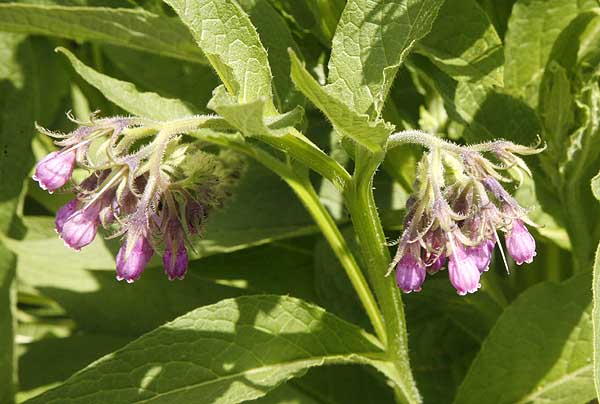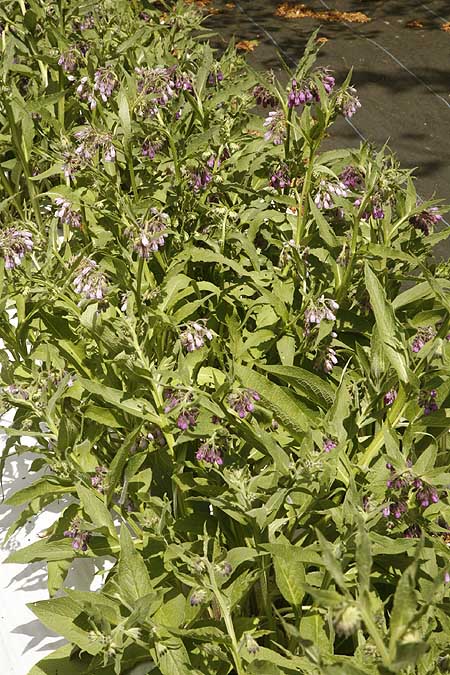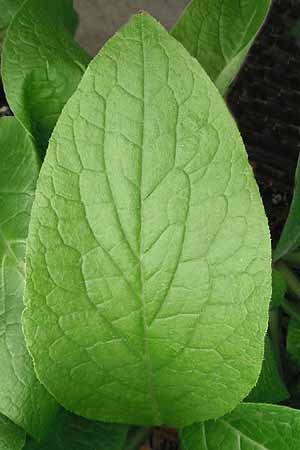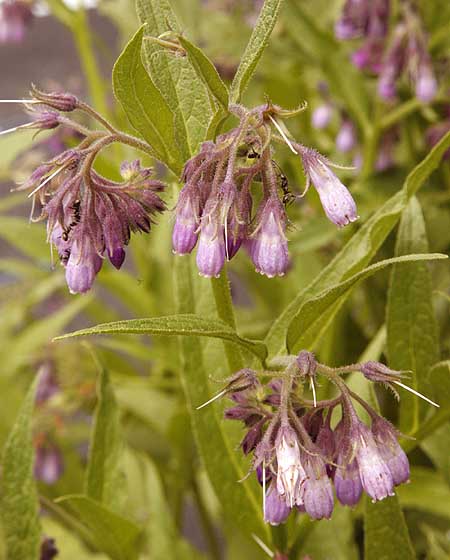A tough perennial hardy to zone 3 that dies down in winter. Needs full sun and water but will take over unwanted area of the garden if left alone. Bees, butterflies and beneficial insects love this plant. It has very deep roots and will bring up nutrients from deep underground and concentrate them in the leaves. For this reason many people grow it as a living fertilizer. The leaves are cut and used to mulch and feed other plants. Its also the best plant to use for healing external injuries. It needs very little care once established, its pretty and its very useful, what more could you want in one plant. A must for any garden that has space for it. So far the deer don't seem to eat it.
Description of Comfrey (Symphytum officinale) .
A perennial hardy to zone 3 that dies down in the winter. Shoots arise in early
spring and the base leaves of comfrey can be large up to 10 inches long and
2 inches wide. They are basically ovate shaped with a point at the outer end
and more blunt that the stem end. Some leaves can be almost straight across
at the base while others are more rounded each side of the stem. The whole leaf
is totally covered in rough hairs and are deeply veined giving them interesting
texture. A single root base leaves will form a roundly circular spray of wide
leaves, this becomes more muddled when many roots are close together forming
a mixed clump. In late spring the plant puts up tall stout angular, hollow stems
covered with bristly hairs. These can reach 2-3 feet in height. Leaves on the
stem are slightly different shape than base leaves being more lance shaped with
points at both ends. The middle vein continues strongly into the stem of the
leaf which runs down a portion of the stem rather than joining at a node. (known
as decurrent). Leaves decrease in size as the ascend the much branched stems
and terminate in flower clusters. These produce one sided clusters of drooping
flowers that can be either pink, purple or white. Each flower has its own short
stalk and are bell shaped with the stem curling inwards in s mini spiral with
the flowers gradually tapering from a fully open bloom through half open to
tiny bud at the end of the curved stem. Flowers are followed by fruits which
consist of four small shining nutlets. Flowers usually begin to appear in early
spring of the plants second year and can continue throughout the summer.
Comfrey produces a thick aggressive deep taproot that has the ability to mine
nutrients from the subsoil, primarily accumulating potassium, but also nitrogen,
phosphorus, trace minerals and micro-nutrients. These nutrients are pulled up
by its roots and concentrated in its leaves.
Once comfrey starts growing, it doesn't stop until the first cold snap, it will
go dormant in the winter and reemerge in early spring. In ideal locations comfrey
can self seed and produce large patches or dense ground cover beating out all
weeds. The flowers are adored by butterflies and bees and it makes an excellent
insect forage plant.
HOW TO GROW Comfrey (Symphytum officinale).
Location and care
Choose the location for your comfrey bed with care. In good conditions plants
will grow into larger clumps every year and can also spread by self seeding.
Can make an excellent ground cover in unwanted areas of the garden. Since it
has such large tap roots it is almost impossible to dig up every scrap once
plants have been located so its almost impossible to eradicate it once established.
Locate well away from other plants as large leaves will quickly overwhelm other
plants and take over.
Thrives in full sun but will tolerate some small amount of shade during the
day. Needs quite a lot of water so is ideal for slightly wet areas and good
amounts of organic material. However waterlogged soils will
will cause the roots
to rot so reasonable drainage is best. For sandy soils add a good amount of
organic material to help hold the water this plant will need. If in dryer area
daily watering may be required to keep plants healthy.
Plants should be at least two feet apart, with three feet between rows. Once
established comfrey plants can become rather large and will totally fill an
area. If planting as ground cover slightly narrower distances can be used but
plants will most likely grow to fill this area in about three years from seed.
Works very well under small fruit trees or small orchard settings where there
is plenty of light. Once established will keep away other weeds. Before planting
ensure that all perennial weed roots have been removed as once established the
leaf density make it hard to weed. Add plenty of mulch, manure or other organic
material. Comfrey can never get enough will even take raw manure without getting
leaf scorch.
In the winter the plants go dormant and a good layer of manure can be applied.
Growing Comfrey (Symphytum officinale) from seed.
Comfrey germination can be a little erratic. Some seeds need to have cold stratification
(cold moist period) before they will germinate while most of the seeds seem
happy with just a period of cold. All our seeds have been cold treated but not
stratified. Germination rates for spring sowing tend to be around 80% for such
seeds. Comfrey often grows fairly slowly to begin with so for these reasons
we recommend starting indoors in pots, but direct seeding is an option.
Direct sowing. Its often best to direct sow in fall so the seeds are naturally stratified over the winter. Spring sowing is also an option but some gaps may arise. Sow about 2 feet apart and keep weeds down until plants are large enough to beat out weeds. Alternatively sow closer together and thin as plants increase in size.
Starting indoors (recommended). Sow in medium individual cell flats or two seeds to a small pot. See our general growing instructions for more detailed information. Grow on until plants are at least 3 inches across when they should be placed outside to harden off. Transplant to well prepared bed placing plants at least 2 feet apart with three feet between rows. Plants can be located slightly closer together if grown as ground cover but they will most likely fill the space at this distance in about three years. Water well and keep moist until established.
For those who want all the seeds to germinate. Keep the seed tray or pots that have not germinated. When transplant plants dig these 'empty' pots into areas between the plants that you would like to fill and leave them for overwinter stratification. In most cases the seeds will germinate for the following spring. Mark where you planted them so they don't get weeded out by mistake.
Is cold Stratifying worth it for comfrey?
For many plants it is essential or they just wont germinate. For comfrey, we
don't think so. We have consistently germinated about 80% of our seeds without
it, for us that is enough. For every seed there are always some that don't germinate
no matter what. If you are looking for higher rates then it might be worth your
while but it takes time and patience that many people just don't have. If you
want to do so see our stratification guide.
Why grow comfrey? It's a living plant powerhouse!
Many people love to grow this plant simply because the thick very deep taproots
will mine nutrients and concentrate them in the leaves. This makes it a powerhouse
of plant nutrients. It makes awesome compost bringing up all the good soil minerals
and concentrating them where we can reach them. Comfrey contains more Nitrogen
(N), Phosphorus (P) and Potash (K) than most
commercial feeds available and
around twice as much Potash as farmyard manure or indoor compost. Thus the leaves
can be cut several times a year and composted down to feed other plants in the
garden especially vegetables.
Leaves can also be cut, chopped and laid out as a green mulch around plants
to rot down and transfer nutrients to treasured plants. Leaves chopped or whole
can be placed in furrows when planting potatoes and plant transplants. Comfrey
is often used as a understory in orchards where the leaves are cut several times
a year and allowed to drop in place feeding the trees naturally.
It also makes a wonderful compost activator since it contains so many nutrients
it kick starts the microbes that break down the plant material, they go into
overdrive and break down material faster making quicker better compost. Leave
can also be soaked and fermented to make 'compost tea' that can then be used
to water plants and even house plants for high energy plant boost.
Animal fodder.
It has been reported that comfrey leaves are 22% protein. Whatever the reason
domestic animals seem to like the leaves. It can be happily fed to goats, cows,
sheep, chickens, ducks. Some organic dairy farmers state that it improves the
milk and increases production.
Does this mean wildlife will eat it? Well, we don't know. So far nothing has
eaten our comfrey and its right next to where the deer like to break through
our fence!
Harvesting Comfrey (Symphytum officinale).
Comfrey has little hairs on the leaves, which can irritate, so wearing gloves
is recommended
First you need to decide what you are growing the comfrey for. If you want flowers
for wildlife then don't cut too many leaves. If you want to harvest the leaves
then cut the flower stalks off as they come up to put more energy into leaf
production..
Comfrey can grow very quickly if given the right conditions. Do not harvest
plants until the second year to allow them to establish themselves. It might
seem tempting but you will be rewarded with much larger stronger plants if you
let them establish first. In some cases a harvest can be taken in the fall of
the first year if plants have established quickly and well.
In the second year harvesting can begin when the flower stems begin to appear.
Using the tool you are most comfortable with (often shears but some people like
to use a sickle, scythe or knives) cut them about 6 inches from the ground.
Two to three additional cuts are usually possible throughout the year but this
will vary depending on your climate zone. In most cases you can get about 4
pounds of leaf per cutting from a mature plant for each cutting. Stop cutting
in later summer to early fall to allow the plants time to collect nutrients
and store their energy in the roots for next years spring growth. Cutting too
much will weaken plants and they will die.
Root harvest is done in the fall after the leaves have died back. It
can be tough work because roots can go very deep.
Medical uses of Comfrey (Symphytum officinale).
Comfrey has been used for centuries as a healing herb. Both the roots and the
leaves are used. It is one of the best plants to use for healing wounds. It
contains a substance called 'allatoin' which stimulates cell proliferation that
will speed up the healing process. This substance is now synthesized in the
pharmaceutical industry and used in healing creams. It is very important that
any wound be well cleaned and infection removed before applying any home made
poultices or creams since comfrey can heal the outer skin very rapidly which
could seal in any deeper infection. Ointments made from Comfrey can be applied
to the skin to heal bruises, cuts, sprains, sores, eczema and varicose veins.
It is also
used to treat more deep seated problems such as pulled muscles and
ligaments, fractures, osteoarthritis and broken bones.
The internal use of comfrey also spans centuries. It has long been used to treat many stomach complaints especially ulcers. However it has fallen into disfavor because it contains pyrrolizidine alkaloids that are toxic to the liver and have a cumulative effect. The largest concentrations are found in the roots, often 16 times that of the older leaves. Younger leaves seem to contain almost none. However herbal research has shown that most people would need to consume large quantities on a regular basis for any damage to occur and the positive health-promoting properties of the plant most likely far outweigh any possible disbenefits, especially if only the younger leaves are used. Recently, with the advent of more research. there has been a resurgence in the use of comfrey and it is being added to many herbal remedies once again. However care should be taken consuming if consuming the plant in a home setting. Consult a trained herbalist before consuming too much of the plant.
Edible uses of Comfrey (Symphytum officinale).
Not used too much today due to possible liver toxicity. The plant can be dried
and used in a tea, the roots can be roasted and used in a coffee substitute.
Young leaves ONLY should be used as a vegetable, they can be eaten raw or cooked
but since the leaf has a hairy texture and is fairly mucilaginous the best option
is to use raw and finely chopped in salads. The taste, in all cases, is sharp
and not the most pleasant eating. Probably good as a survival food in post apocalypse
conditions but otherwise there are much better choices available.
Other names
Knitbone, Bruisewort, Healing herb, Miracle herb, Common Comfrey, Knitback,
Consound, Blackwort, Bruisewort, Slippery Root, Boneset, Yalluc (Saxon), Gum
Plant, Consolida, Ass Ear.










